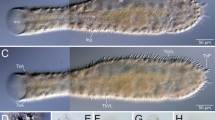Abstract
The structure of the digestive gland epithelium of a terrestrial isopod Porcellio scaber has been investigated by conventional scanning electron microscopy (SEM), focused ion beam–scanning electron microscopy (FIB/SEM), and light microscopy in order to provide evidence on morphology of the gland epithelial surface in animals from a stock culture. We investigated the shape of cells, extrusion of lipid droplets, shape and distribution of microvilli, and the presence of bacteria on the cell surface. A total of 22 animals were investigated and we found some variability in the appearance of the gland epithelial surface. Seventeen of the animals had dome-shaped digestive gland “normal” epithelial cells, which were densely and homogeneously covered by microvilli and varying proportions of which extruded lipid droplets. On the surface of microvilli we routinely observed sparsely distributed bacteria of different shapes. Five of the 22 animals had “abnormal” epithelial cells with a significantly altered shape. In three of these animals, the cells were much smaller, partly or completely flat or sometimes pyramid-like. A thick layer of bacteria was detected on the microvillous border, and in places, the shape and size of microvilli were altered. In two animals, hypertrophic cells containing large vacuoles were observed indicating a characteristic intracellular infection. The potential of SEM in morphological investigations of epithelial surfaces is discussed.



Similar content being viewed by others
References
Drobne D, Štrus J, Žnidaršič N, Zidar P (1999) Morphological description of bacterial infection of digestive glands in the terrestrial isopod Porcellio scaber (Isopoda, Crustacea). J Invertebr Pathol 73:113–119. doi:10.1006 /jipa.1998.4818
Drobne D, Milani M, Lešer V, Tatti F (2007) Surface damage induced by FIB milling and imaging of biological samples is controllable. Microsc Res Tech 70:895–903. doi:10.1002/jemt.20494
Drobne D, Milani M, Leser V, Zrimec A, Žnidaršič, Kostanjšek R, Štrus J (2008) Imaging of intracellular spherical lamellar structures and tissue gross morphology by a focused ion beam/scanning electron microscope (FIB/SEM). Ultramicroscopy 108:663–670. doi:10.1016/j.ultramic.2007.10.010
Hames CAC, Hopkin SP (1989) The structure and function of the digestive system of terrestrial isopods. J Zool 217:599–627
Hames CAC, Hopkin SP (1991) A daily cycle of apocrine secretion by the B cells in the hepatopancreas of terrestrial isopods. Can J Zool 69:1931–1937
Hopkin SP, Martin MH (1982) The distribution of zing, candium, led and coper within the hepatopancreas of a woodlouse. Tissue Cell 14:703–715
Kohler HR, Huttenrauch K, Berkus M, Graff S, Alberti G (1996) Cellular hepatopancreatic reactions in Porcellio scaber (Isopoda) as biomarkers for the evaluation of heavy metal toxicity in soils. Applied Soil Ecology 3:1–15. doi:10.1016/0929-1393(95)00073-9
Lapanje A, Drobne D, Nolde N, Valant J, Muscet B, Leser V, Rupnik M (2008) Long-term Hg pollution induced Hg tolerance in terrestrial isopod Porcellio scaber (Isopoda, Crustacea). Environ Pollut 153:537–547. doi:10.1016/j.envpol.2007.09.016
Lešer V, Drobne D, Vilhar B, Kladnik A, Žnidaršič N, Štrus J (2008) Epithelial thickness and lipid droplets in the hepatopancreas of Porcellio scaber (Crustacea: Isopoda) in different physiological conditions. Zoology 111:419–432. doi:10.1016/j.zool.2007.10.007
Lešer V, Drobne D, Pipan Z, Milani M, Tatti F (2009) Comparison of different preparation methods of biological samples for FIB milling and SEM investigation. Journal of Microscopy-Oxford 233:309–319. doi:10.1111/j.1365-2818.2009.03121
Odendaal JP, Reinecke AJ (2003) Quantifying histopatho-logical alterations in the hepatopancreas of the woodlouse Porcellio laevis (Isopoda) as a biomarker of cadmium exposure. Ecotoxicol Environ Saf 56:319–325. doi:10.1016/S0147-6513(02)00163-X
Pawley J (1997) The development of field-emission scanning electron microscopy for imaging biological surfaces. Scanning 19:324–336
Storch V (1984) The influence of nutritional stress on the ultrastructure of terrestrial isopods. Symp Zool Soc 53:167–184
Štrus J (1987) The effects of starvation on the structure and function of the hepatopancreas in the isopod Ligia italica. Investig Pesq 51:505–514
Wägele J-W, Harrison FW, Humes AG (1992) Microscopic anatomy of invertebrates. Crustacea, Wiley-Liss, New York 9:529–617
Wood S, Griffith BS (1988) Bacteria associated with the hepatopancreas of the woodlice Oniscus asellus and Porcellio scaber (Crustacea, Isopoda). Pedobiologia 31:89–94
Wang Y, Stingl U, Anton-Erxleben F, Geisler S, Brune A, Zimmer M (2004a) “Candidatus Hepatoplasma crinochetorum,” a new, stalk-forming lineage of Mollicutes colonizing the midgut glands of a terrestrial isopod. Appl Environ Microbiol 70:61–66. doi:10.1128/AEM.70.10.6166-6172.2004
Wang Y, Stingl U, Anton-Erxleben F, Geisler S, Brune A, Zimmer M (2004b) ‘Candidatus Hepatincola porcellionum’ a new, stalk-forming lineage of Rickettsiales colonizing the midgut glands of a terrestrial isopod. Arch Microbiol 181:299–304. doi:10.1007/s00203-004-06555-7
Žnidaršič N, Štrus J, Drobne D (2003) Ultrastructural alterations of the hepatopancreas in Porcellio scaber under stress. Environ Toxicol Pharmacol 13:161–174. doi:10.1016/S1382-6689(02)00158-8
Acknowledgments
We thank FEI Italy for the access to Strata DB235 M at the University of Modena e Reggio Emilia, Italy. This work was supported by the Slovenian Ministry of Higher Education, Science, and Technology (J1-9475). We thank Bill Milne for English editing.
Conflicts of interest
The authors declare that they have no conflict of interest.
Author information
Authors and Affiliations
Corresponding author
Rights and permissions
About this article
Cite this article
Millaku, A., Lešer, V., Drobne, D. et al. Surface characteristics of isopod digestive gland epithelium studied by SEM. Protoplasma 241, 83–89 (2010). https://doi.org/10.1007/s00709-010-0110-3
Received:
Accepted:
Published:
Issue Date:
DOI: https://doi.org/10.1007/s00709-010-0110-3




